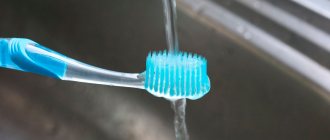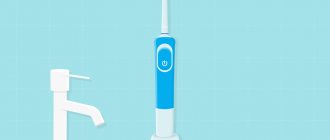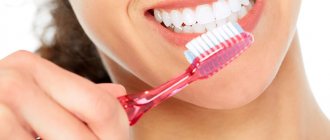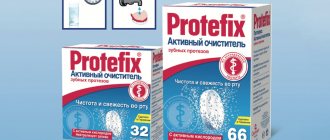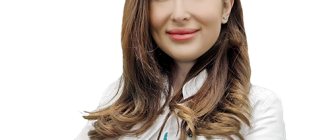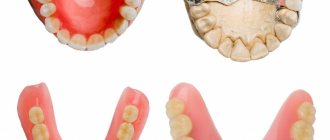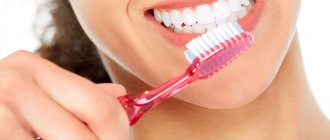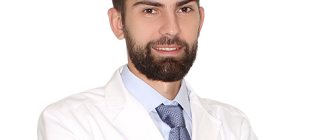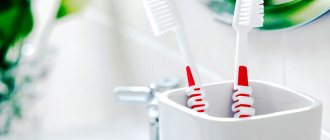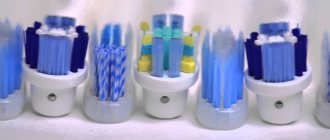The very first toothbrush: what was it like?
In this article
- The very first toothbrush: what was it like?
- When did toothbrushes become popular?
- In what year was the modern brush invented?
- The first electric toothbrush: when did it appear?
- Modern models: variety of choice
People have been thinking about oral hygiene long before there was a toothbrush. This is confirmed by archaeological excavations, during which numerous devices for cleaning teeth were found. For example, one such device was a wooden stick, one edge of which was pointed, and the other was used for chewing to remove plaque. These “brushes” were made from trees rich in essential oils.
The first toothbrushes were twigs, tufts of grass, bird feathers, animal bones and even porcupine quills.
Interesting facts about the toothbrush
- Until the early 20th century, most Americans did not brush their teeth.
- People who brush their teeth three times a day are less likely to be overweight. Japanese scientists came to this conclusion. They reportedly studied the lifestyles of 14 thousand people.
- Have you ever wondered how many times you can reinvent the toothbrush? Imagine, according to statistics, more than 3,000 toothbrush models have been patented since the 60s of the last century!
- The most expensive toothbrush in the world was invented and released by Philips. The electronic brush head makes more than 600 movements in just one second. For the first time, its mechanism that creates vibrations is located not in the head, but in the handle of the brush. The entire mechanism is reliably protected from moisture penetration during charging.
Go to section: 2. Oral hygiene
When did toothbrushes become popular?
At the end of the 15th century, the Chinese invented a device that was much more like a modern toothbrush. It looked like a bamboo stalk with the stiff bristles of a wild boar attached to it. The toothbrush was used dry - without paste or powder.
Gradually, the invention of the Chinese began to spread throughout the world and even reached our country. During the time of Ivan the Terrible, dental brooms were popular, which looked like a wooden stick with bristles at the end.
In the mid-17th century, a book by the French dentist Pierre Fauchard appeared, which described dental diseases and methods for their removal. In his book, the dentist recommended brushing your teeth daily, which contributed to the rise in popularity of the toothbrush.
History of the toothbrush lesson plan on the surrounding world (senior group) on the topic
History of the toothbrush.
Program content
- Continue to introduce the rules of personal hygiene;
- Introduce the history of the toothbrush;
- Strengthen the ability to properly brush your teeth and care for a toothbrush;
- Cultivate a desire to lead a healthy lifestyle
- Cultivate a positive attitude towards dentists.
GCD move:
Children enter the group and stand in a circle with the teacher.
Educator: Let's say hello to everyone.
Hello, palms! (clap-clap) Hello, legs! (top-top) Reeds, wake up! (clack) Eyes, open! (blink)
Let us shout together to the whole wide world: “Hello, sun! (Waving to the sun.) Guests, hello! (Wave to the guests and go to their chairs)
To the music, Petrushka appears behind the screen.
Educator: Hello, Petrushka.
Parsley: Guys, I ran away from Mom, she teaches me and teaches me.
Educator: Why not teach you? You don't even know the rules of personal hygiene. Look at your hands and face, they are dirty.
Parsley: Okay, I’ll wash it, I already know how to wash myself. (Spits on his hands, rubs them; rubs his face with his hands, without water)
Educator: Is this how you wash your face? Guys, how should you wash your face?
Children: No, you need to wash with soap and water.
Educator: What else should you do in the morning?
Children: Comb your hair.
Parsley: It's simple. (Combs his hair with his hands.)
Educator: Guys, does Parsley comb her hair correctly? How is it necessary? What else do you do in the morning before going to kindergarten?
Children: We brush our teeth with a toothbrush.
Parsley: Oh, okay, I’ll take a brush now... (looks around confusedly, finds several different brushes, doesn’t understand which toothbrush cleans with a shoe brush).
Educator: Parsley, the guys will now show you a toothbrush! (Children point to the toothbrush.)
Parsley: Wow, so interesting, where did it come from?
Educator: Guys, do you know where the toothbrush came from? (children's answers). Now listen to how the toothbrush actually came to be. A long time ago, people lived in caves. They went hunting, cooked and ate the meat of animals obtained there. After eating, pieces of meat got stuck in the teeth, and the person took an ordinary twig from a tree or bush and cleaned his teeth of food debris. It was enough to peel the twig from the bark and chew it. The soaked hairs cleaned the teeth well. Sometimes a person would break the tip of a twig with a stone. This branch resembled a broom. Here's a look at what she looked like. At first, teeth were brushed without any powder or paste, and then they began to use different mixtures, for example, chalk, which not only cleaned teeth of crumbs and food debris, but also whitened them. In India, branches of the neem tree are still sold in bazaars. These branches are peeled from the bark and chewed; they clean the teeth well, and the juice released during chewing, which is pleasant to the taste, strengthens the teeth and destroys microbes. Nowadays, there are many different toothbrushes and scientists come up with new ones all the time. For example, there are already electric brushes that clean your teeth themselves. (the teacher’s story is accompanied by a presentation).
Parsley: So they came up with the idea of brushing my teeth, they’re not dirty anyway, they’re not shoes that need to be polished.
Educator: Now we will conduct an experiment and see that Parsley is mistaken. Go to the tables, take toothpicks, and use the tip of the toothpick to brush your teeth. Now wipe them on black cardboard and examine them. What do you think is white left on the cardboard? (children's answers) This is dental plaque in which harmful microbes accumulate. How can you destroy harmful microbes?
Children: Brush your teeth.
Educator: Yes, you need to brush your teeth in the morning and evening so that germs do not accumulate. How should you brush your teeth properly? Let's show you, pick up brushes and pictures of teeth. Brush your teeth in the picture. The upper teeth should be brushed from top to bottom, and the lower teeth from bottom to top, so that the bristles of the brush clean out all the remaining food between the teeth. Well done guys, I think now you and Petrushka will brush your teeth correctly. We have brushed our teeth, what should we do now with the brush, how to care for it?
Children: Wash it and put it in a jar.
Educator: Yes, the brush needs to be rinsed with hot water and placed in a separate jar. (wash with fingers and put in a jar) And now you and I will play a game. Stand in a circle. I will tell you various products, and you will tell me whether they are good for your teeth or not. Well done, what foods are harmful to teeth? (sweet) Why? (they destroy teeth) But we still eat sweet foods with you, what should we do after we eat them so that our teeth do not decay. (brush your teeth, chew gum, rinse your mouth) What foods are good for your teeth? (dairy products, seafood, because they contain calcium; fruits and vegetables, because they contain vitamins)
Children sit on chairs.
Educator: And if your teeth still hurt, what should you do? (you need to consult a dentist)
Educator: If your teeth are treated on time, they will not hurt. Today I was at the dentist, had my teeth checked and told the doctor about you guys. The dentist said hello to you, wished you health and gave you this drawing, which shows a diagram of how to properly brush your teeth. We will hang it in a visible place so you don’t forget. Well, did Petrushka remember everything?
Parsley: No, not all.
Educator: Well, let’s remind him guys again. What procedures should be done in the morning before going somewhere? (wash, comb your hair, brush your teeth) Why do you need to brush your teeth? What appears on teeth if you don't brush your teeth? How many times a day should you brush your teeth (2 – morning and evening). How should you brush your teeth correctly? (top down). How to care for your brush? Well done guys, let's give Petrushka a toothbrush so he can brush his teeth.
Parsley: Oh, how beautiful, now I’ll definitely brush my teeth, I’ll run and tell my mom everything. Goodbye guys, thank you.
Children: Goodbye.
Educator: And now that our lesson is over, I suggest you watch a cartoon about a toothbrush.
MUNICIPAL BUDGETARY PRE-SCHOOL EDUCATIONAL INSTITUTION OF GENERAL DEVELOPMENTAL KINDERGARTEN No. 14 “RODNICHOK”
History of the toothbrush
directly – educational activities of the educational field
"Cognition"
(Senior group)
Educator: Karepanova M.A.
Zarinsk 2013
In what year was the modern brush invented?
The very first modern brush appeared in 1780. It was then that the Englishman William Addis began the industrial production of these hygiene products.
The very first brushes had natural bristles, which did not dry well and contributed to the growth of bacteria.
The world really began to use toothbrushes en masse when a brush with nylon bristles appeared. It dried quickly, accumulated bacteria much more slowly than natural ones, and was lightweight and durable, due to which it quickly gained popularity. Oral-B was the very first nylon model.
Initially, ordinary nylon was used for production, which severely scratched teeth and gums, but soon a special “soft” nylon was developed, and the toothbrush became much more comfortable to use.
The first electric toothbrush: when did it appear?
The nylon toothbrush continued its evolution into the 20th century. So, at the end of the 30s, the first electric brush was invented in Switzerland, which worked from the mains. Mass production of electric brushes began in 1960 with the release of the Broxodent model. The manufacturer, the pharmaceutical company Bristol-Myers Squibb, positioned it as a hygiene product for “special” situations. It was planned that the brush would be used by people with impaired motor skills and those who wear braces.
But the device turned out to be so popular and effective that a year later the General Electrics company released a battery-powered model for mass use, and everyone began to use electric brushes.
The history of the toothbrush and toothpaste
The history of the toothbrush
The first predecessors of the toothbrush appeared back in 3500-3000. BC e. These were tree branches with a frayed end, which the inhabitants of Babylon and Ancient Egypt used to clean their teeth. Such “dental sticks” were discovered by archaeologists in the tombs of Egyptian pharaohs. Around 1600 BC. e. The Chinese began making chewing sticks from fragrant tree branches to freshen their breath.
It is believed that the first real toothbrush with natural bristles was invented in the 15th century in China. The instrument was a handle made of bone or bamboo, on which bristles, cut from the scruff of a boar, were attached. When the Asian innovation reached Europe, its design changed slightly: instead of rough pig bristles, softer horsehair or bird feathers were used.
A toothbrush, similar in design to modern dentifrice, was created by Englishman William Addis around 1780. He drilled holes in a piece of cow bone and threaded tufts of pig bristles through them, securing them with glue. More than half a century later, in 1844, the first toothbrush with three-row bristles was introduced.
The transition from natural bristles to artificial fibers in the production of toothbrushes became possible only in the 1930s, when nylon was invented in the laboratories of the American chemical company DuPont. The first toothbrush with nylon bristles appeared in 1938. Despite the tangible benefits, the new brushes remained quite harsh until production technology was improved in 1950 and the hairs became softer.
The first electric toothbrush was created back in 1939, but mass production of electric brushes began only in 1960 with the release of the Broxodent model.
These days, there is a wide range of mechanical and electric toothbrushes on the market to suit every taste. Modern samples have straight or curved plastic handles with a soft rubberized surface, making them so easy and comfortable to hold in your hand. Fibers are typically made from synthetic fibers and vary in firmness. Toothbrush heads also vary in size and shape, from miniature ones for babies to larger ones for older children and adults, from rectangular and oblong to oval and almost round.
And although the general design of a toothbrush has remained virtually unchanged since ancient times, thanks to the constant development of technology, a simple stick with bristles has turned into a modern, ergonomic and safe tool that has incorporated the latest advances in science.
The history of toothpaste
Historians believe that as early as 5000 BC. e. The ancient Egyptians used special mixtures to clean their teeth. It is known that the ancient Greeks and Romans also used cleaning powder, but it appeared in China and India only in 500 BC. e.
Ancient prototypes of toothpastes performed the same functions as their modern counterparts: they kept the mouth clean, whitened teeth, and freshened breath. However, the ingredients of ancient tooth powders were completely different. The Egyptians made them from the ashes left after burning ox hooves, ground burnt eggshells and pumice. The Greeks and Romans included polishing and abrasive substances in the mixture, such as crushed bones and oyster shells, as well as ash and plant roots. In addition, various flavorings were often used as ingredients, which improved the taste of the powder and helped get rid of bad breath. Residents of Ancient China made toothpaste from many different ingredients, including ginseng, mint and salt.
More than a century passed before toothpaste acquired its familiar form. The appearance of more or less modern samples of dental mixtures dates back to the beginning of the 19th century. Many of them contained soap. In the 1800s, betel nut was added to tooth powder in England. Recipes from the 1850s mention chalk among other ingredients, and an encyclopedia from the 1860s tells how to make homemade toothpaste using ground charcoal.
Until the mid-19th century, dentifrices were sold primarily in powder form. In the 1850s, the first toothpaste came in a jar called Crème Dentifrice. In 1873, Colgate began mass producing toothpaste in cans, and in the 1890s, the first Colgate toothpaste was introduced in a tube, like those familiar to each of us.
Until 1945, most toothpastes contained soap, which later gave way to sodium lauryl sulfate. This substance, which gives the paste a smooth and uniform texture, is still a popular ingredient in modern hygiene products.
In the second half of the 20th century, toothpastes began to appear designed to prevent various oral diseases and relieve symptoms such as tooth sensitivity. Fluoride-containing toothpastes for protection against caries have become especially popular, the first examples of which were created in 1914. Toothpastes with low abrasiveness were also invented to avoid damage to the enamel from overzealous brushing.
Today, toothpastes may contain fluorides, dyes, flavors, sweeteners, as well as ingredients that make the toothpaste smooth and foamy and prevent it from drying out. Toothpaste in tubes is still used all over the world, remaining one of the most useful inventions.
Modern models: variety of choice
Modern people have access to both traditional and electric brushes. Recent ones are becoming more advanced and technologically advanced every year. Modern models clean teeth using sound and ultrasonic waves, allow you to adjust the degree of pressure, operate in several modes, and are equipped with a built-in timer to control the cleaning time.
Dentists note that an electric brush can remove more plaque and make it easier to clean hard-to-reach areas. In addition, the use of the device increases the duration of cleaning, which has a positive effect on its quality.
If you are unsure which brush to choose for daily use, you should consult your dentist. The doctor will check the condition of your teeth and gums and assess whether they can provide effective and safe care.
